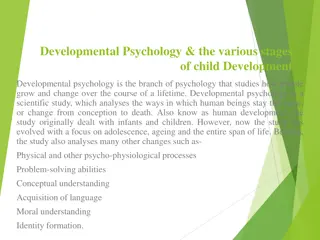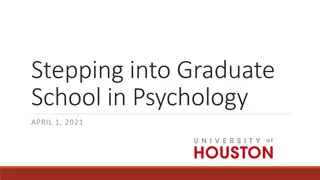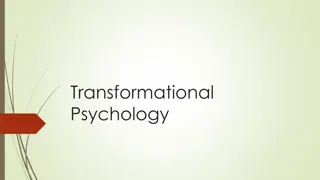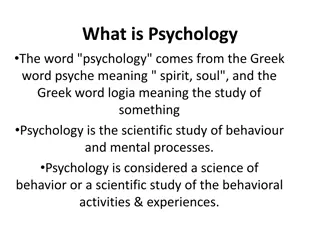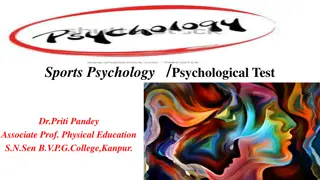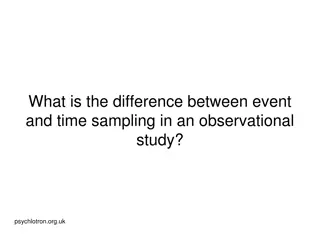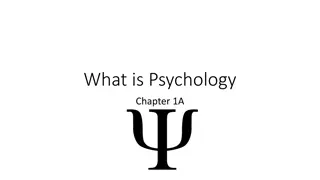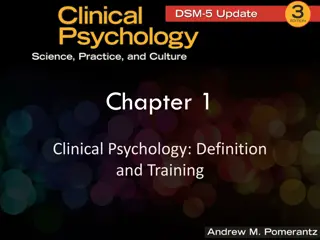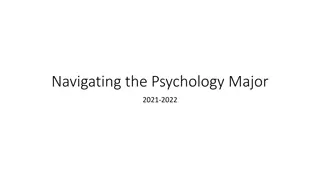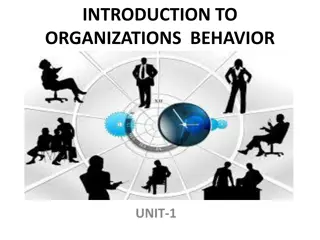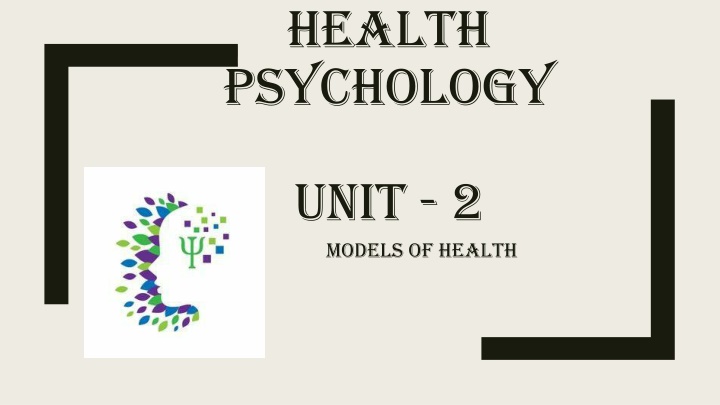
Understanding Models of Health in Health Psychology
Explore the field of health psychology, focusing on models like the Bio-Psychosocial Model and others, which examine the interplay between biological, psychological, and social factors in health and illness. Learn about the roles individuals play in their health and treatment within these models.
Download Presentation

Please find below an Image/Link to download the presentation.
The content on the website is provided AS IS for your information and personal use only. It may not be sold, licensed, or shared on other websites without obtaining consent from the author. If you encounter any issues during the download, it is possible that the publisher has removed the file from their server.
You are allowed to download the files provided on this website for personal or commercial use, subject to the condition that they are used lawfully. All files are the property of their respective owners.
The content on the website is provided AS IS for your information and personal use only. It may not be sold, licensed, or shared on other websites without obtaining consent from the author.
E N D
Presentation Transcript
HEALTH PSYCHOLOGY UNIT - 2 Models of Health
What is Health Psychology? Health psychology is the study of psychological and behavioral processes in health, illness, and healthcare. It is concerned with understanding how psychological, behavioural, and cultural factors contribute to physical health and illness. It deals with the subject of health and illness by merging all knowledge of biological, behavioral, social and psychological Sciences. Health Psychology is basically applying the psychological theory to health related practices.
Models of Health Bio Psychosocial Model of Health Socio Cultural Model of Health The Health Belief Model HBM Protection Motivation Model Leventhal s self regulatory Model The Theory of Planned Behaviour TPB Schwarzer s Health Action Process approach HAPA The Transtheoretical Model
Bio-Psychosocial Model The Bio-Psychosocial Model views health and illness behaviours as products of biological characteristics (such as genes), behavioural factors (such as lifestyle, stress, and health beliefs), and social conditions (such as cultural influences, family relationships, and social support). The model specifically examines how these aspects play a role in topics ranging from health and disease models to human development This model was developed by George L. Engel in 1977.
Focal area Bio-psychosocial model What causes illness? Biological (virus) , psychological (beliefs, behaviour) and social (unemployment) Individuals should be held responsible for his/her health and illness Who is responsible for illness? The focus is the whole person to be treated not just their physical illness; the patient is therefore responsible for their treatment (e.g. taking the medication or changing their behaviour). Who is responsible for treatment? Health and illness exist on a continuum. Individuals progress along this continuum from health to illness and back again What is the relationship between health and illness?
Focal area Bio-psychosocial model What is the relationship between the mind and the body? The focus is on an interaction between the mind and the body. The mind and body interact Psychological factors not only as possible consequences of illness but as contributing to it at all stages along the continuum from healthy to being ill What is the role of psychology in health and illness?
Socio Socio Cultural Model Cultural Model of Health of Health The beginning of the 20th century featured an understanding of health that was dominated by a biomedical perspective, characterized by a reductionist point of view in which health was defined as the absence of illness. This view has long been replaced by a bio psychosocial model that emphasizes the role played by socio-cultural forces in the shaping of health (and illness) and related psychological experiences (Engel 1977). In 1948, the World Health Organization (WHO) defined health as a complete state of physical, mental and social well-being and not merely the absence of disease or infirmity, calling attention to the complexity and multidimensionality of the concept.
Socio Socio- -cultural Theory cultural Theory Sociocultural theory is an emerging theory in psychology that looks at the important contributions that society makes to individual development. This theory stresses the interaction between developing people and the culture in which they live. Sociocultural theory also suggests that human learning is largely a social process.
Socio- Cultural Model Of Health Aristotle said Man is an social animal, He cannot live without society. People live in the social world. They form many relationships like a family, friends etc The term social cultural means something that involves the social and cultural aspects. Society affects a person s health by promoting certain values of culture. As members, we can express the values of the society by writing our thoughts in the media, T.V, newspapers. Our community is made up of people who live very close to each other such as living in the same city. These people influence each other where these effects can be seen prominently in the community, research has been conducted and it has been found that social health practices such as smoking cigarettes , drinking alcohol etc. E.g.. Anthropology Sociocultural is knowing about the people around you and their family backgrounds.
Health Belief Model It is the oldest known and most widely used model of health behaviour around which all models developed. It was initialized by Rosenstok 1966 and then refined by baker and maiman in 1975. The health belief model (HBM) is a social psychological health behaviour change model developed to explain and predict health-related behaviours, particularly in regard to the uptake of health services. The health belief model suggests that people s beliefs about health problems, perceived benefits of action and barriers to action, and self-efficacy explain engagement (or lack of engagement) in health-promoting behaviour.
The HBM derives from psychological and behavioral theory with the foundation that the two components of health-related behavior are 1) the desire to avoid illness, or conversely get well if already ill; and, 2) the belief that a specific health action will prevent, or cure, illness. There are six constructs of the HBM. The first four constructs were developed as the original tenets of the HBM. The last two were added as research about the HBM evolved:- 1. Perceived susceptibility - This refers to a person's subjective perception of the risk of acquiring an illness or disease. There is wide variation in a person's feelings of personal vulnerability to an illness or disease. 2. Perceived severity - This refers to a person's feelings on the seriousness of contracting an illness or disease (or leaving the illness or disease untreated). There is wide variation in a person's feelings of severity, and often a person considers the medical consequences (e.g., death, disability) and social consequences (e.g., family life, social relationships) when evaluating the s\severity. 3. Perceived benefits - This refers to a person's perception of the effectiveness of various actions available to reduce the threat of illness or disease (or to cure illness or disease). The course of action a person takes in preventing (or curing) illness or disease relies on consideration and evaluation of both perceived susceptibility and perceived benefit, such that the person would accept the recommended health action if it was perceived as beneficial. ___
4. Perceived barriers - This refers to a person's feelings on the obstacles to performing a recommended health action. There is wide variation in a person's feelings of barriers, or impediments, which lead to a cost/benefit analysis. The person weighs the effectiveness of the actions against the perceptions that it may be expensive, dangerous (e.g., side effects), unpleasant (e.g., painful), time-consuming, or inconvenient. 5. Cue to action - This is the stimulus needed to trigger the decision-making process to accept a recommended health action. These cues can be internal (e.g., chest pains, wheezing, etc.) or external (e.g., advice from others, illness of family member, newspaper article, etc.). 6. Self-efficacy This refers to the level of a person s confidence in his or her ability to successfully perform a behavior. This construct was added to the model most recently in mid- 1980. Self-efficacy is a construct in many behavioral theories as it directly relates to whether a person performs the desired behavior.
Limitations of Health Belief Model Limitations of Health Belief Model There are several limitations of the HBM which limit its utility in public health. Limitations of the model include the following:- It does not account for a person's attitudes, beliefs, or other individual determinants that dictate a person's acceptance of a health behavior. It does not take into account behaviors that are habitual and thus may inform the decision-making process to accept a recommended action (e.g., smoking). It does not take into account behaviors that are performed for non-health related reasons such as social acceptability. It does not account for environmental or economic factors that may prohibit or promote the recommended action. It assumes that everyone has access to equal amounts of information on the illness or disease. It assumes that cues to action are widely prevalent in encouraging people to act and that health actions are the main goal in the decision-making process.



